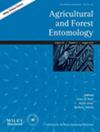Potential biodiversity maps of Geadephaga (Coleoptera) from subantarctic forests: Relating diversity patterns and conservation hotspots with forest integrity Mapas de biodiversidad potencial de los Geadephaga (Coleoptera) del bosque subantártico: relacionando patrones de diversidad y hotspots de conservación con la integridad del bosque
IF 1.8
3区 农林科学
Q2 ENTOMOLOGY
引用次数: 0
Abstract


来自亚南极森林的 Geadephaga(鞘翅目)潜在生物多样性地图:将多样性模式和保护热点与森林完整性联系起来
潜在生物多样性地图(PBMs)可以确定具有不同保护潜力的地区,从而支持有关生物多样性管理和保护的政治决策。由于这些地图很少针对不显眼的物种绘制,我们建议为属于鞘翅目(Geadephaga)的物种绘制潜在生物多样性地图,鞘翅目(Geadephaga)是甲虫的一个类群,在森林生态系统中作为捕食者为抑制害虫和提供其他生态系统服务做出了贡献。鉴于人类活动正在降低森林的完整性,我们认为认识 Geadephaga 的多样性模式与退化森林的关系至关重要。我们为与亚南极森林相关的 Geadephaga 绘制了这些地图,其中考虑了物种丰富度、特异性和稀有性等多样性指标,以确定每种多样性指标与不同森林完整性水平之间的空间关系,并识别潜在的热点地区,提出保护重点。结果表明,从北到南,物种丰富度和物种特异性的得分呈纬度递减模式,但整个地区的物种稀有性则呈斑块模式。结果还显示,多样性指标得分较高的地区与退化森林重叠,而热点地区之间的空间重叠程度较低。在这项工作中,我们首次以相对较高的空间分辨率为栖息在亚南极森林中的 Geadephaga 提供了三种不同多样性指标的区域 PBM 地图。这些地图不仅是识别这些昆虫潜在多样性模式的工具,还为保护决策提供了有价值的信息。
本文章由计算机程序翻译,如有差异,请以英文原文为准。
求助全文
约1分钟内获得全文
求助全文
来源期刊

Agricultural and Forest Entomology
农林科学-昆虫学
CiteScore
3.60
自引率
6.20%
发文量
66
审稿时长
>24 weeks
期刊介绍:
Agricultural and Forest Entomology provides a multi-disciplinary and international forum in which researchers can present their work on all aspects of agricultural and forest entomology to other researchers, policy makers and professionals.
The Journal welcomes primary research papers, reviews and short communications on entomological research relevant to the control of insect and other arthropod pests. We invite high quality original research papers on the biology, population dynamics, impact and management of pests of the full range of forest, agricultural and horticultural crops.
 求助内容:
求助内容: 应助结果提醒方式:
应助结果提醒方式:


